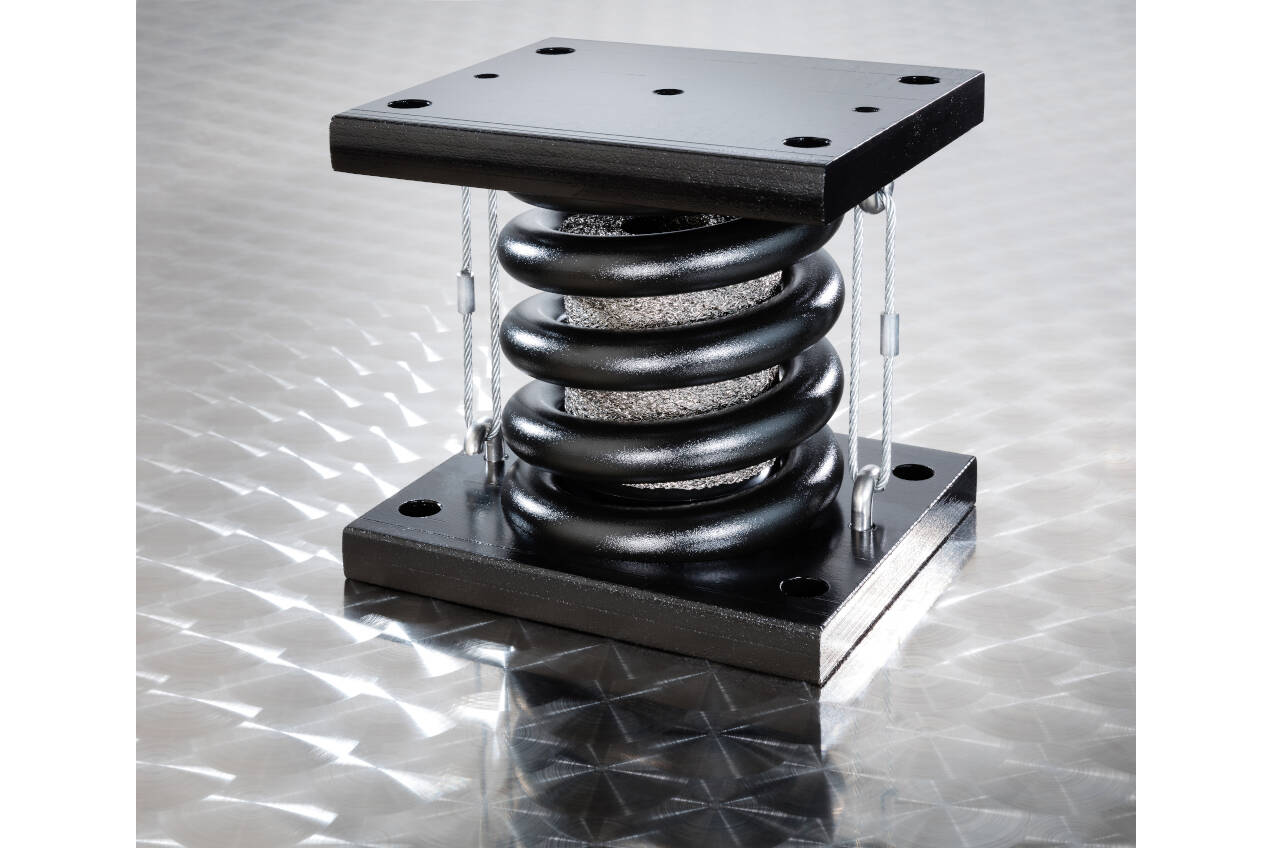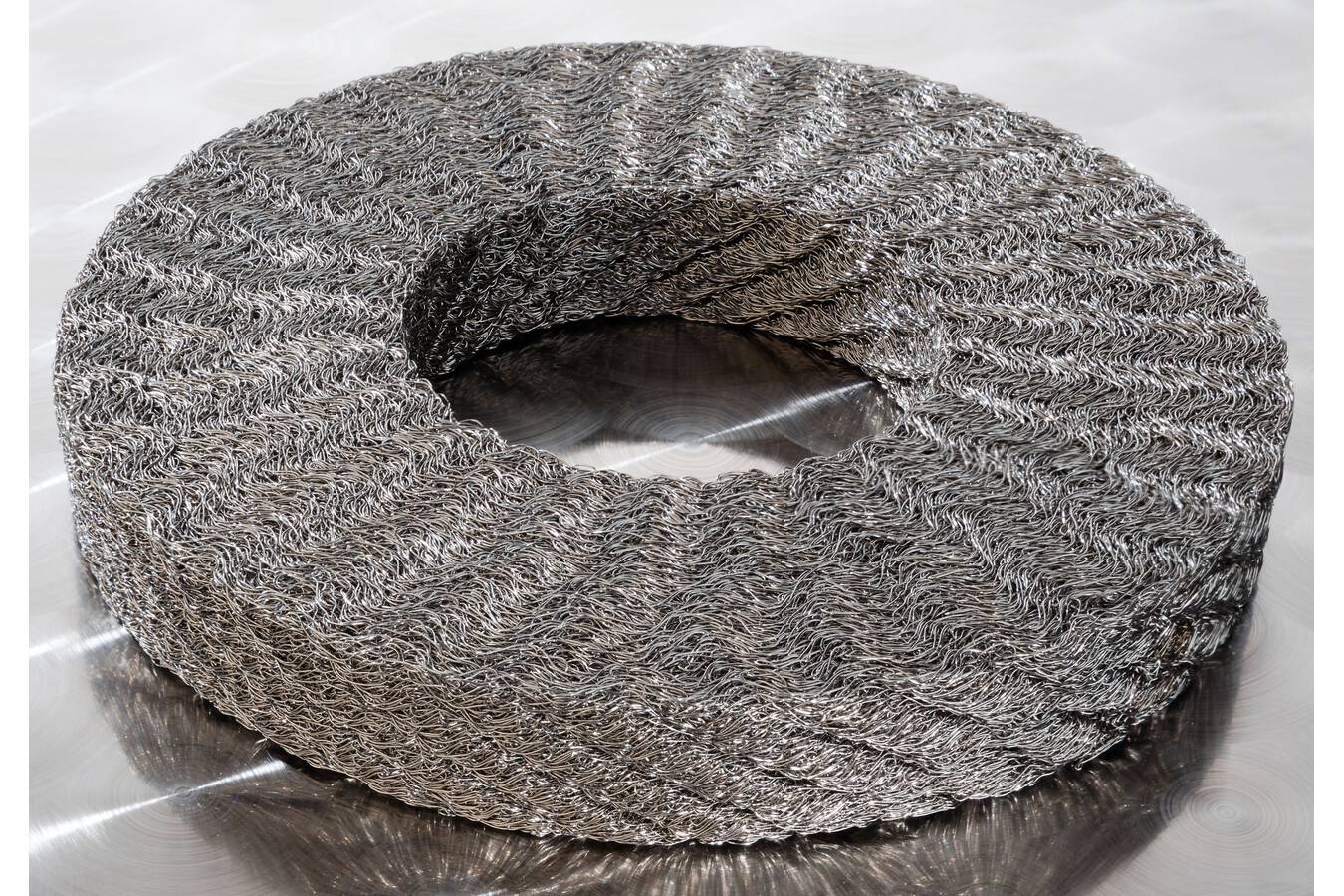Wire mesh vibration dampers as an alternative to the standard
Almost everyone is familiar with vibration dampers made of elastomers. When conditions get tougher, rubber-based vibration isolators reach their limits.
Production in a multi-phase process, partly by hand
The basis or the main element of every vibration damper is the damping pad made of stainless-steel wire. This is produced in a multi-stage process. First and foremost is the knitting of several stainless-steel wires into a stocking. This stocking is then rolled to create a mat. While these processes are automated, the next step is manual. The existing mat is pulled over a mandrel and brought into its mostly cylindrical shape. At the end of production, this blank is pressed and spot-welded to create an elastic molded part. This is used as a damping pad.
Design parameters
An element is characterized by the same values that describe the corresponding geometric shape. For the cylindrical cushion, the outer diameter, inner diameter and height are required as a basis. For a rectangular cushioning element, the width, length and height. Other shapes can be adapted based on the geometry. The volume or density can be deduced from the respective mass of an element. The weight or density is imperative as these parameters determine how soft or hard the vibration damper will end up being.
Shapes and types of wire mesh
As already mentioned above, the standard shapes are the cylinder or the rectangle. These can be manufactured either over the entire surface or with a through hole. In this way, they can be very well adapted to the relevant application and the connection to it. Cushions with an integrated heel are ideal for this purpose, which can be easily screwed into a profile.
In addition to damping pads with heels, there are also elements with a central collar that can be integrated into a profile frame, for example. This provides additional radial stability in the damping system and prevents the cushion from slipping. A possible rigid connection with the profile frame, which leads to the transmission of vibrations, can thus be prevented.
Furthermore there are also pillows in special shapes, which are more expensive to produce. These can be elements with different drafts on both sides. Dampening cushions with several holes, heels or steps can also be produced. Standard materials are 1.4301 and 1.4404.
How a wire mesh works
The function of a damping pad is based on the internal friction of the knitted wires. During the vibration-induced movement, the stainless-steel wires inside the cushion rub against each other. The energy introduced into the cushion is converted into heat and ”pumped” out of the element through the existing channels between the wires.
Advantages of a metal damper
A first big advantage of the vibration damper made of knitted wire mesh is the material itself. The stainless-steel does not show any instability at low or high temperatures. Damping pads made of 1.4301 can be used without restrictions up to temperatures of 300°C. Above this range, use at higher temperatures is also possible by using 1.4404 or 1.4841.
Damping cushions are dimensionally stable in the dynamic load range of up to five times the static load and return to their original shape under normal loads. In this way, temporary force peaks can be well compensated. It is precisely these force peaks that can throw a system out of balance and thus cause the machine to be in an unintended position. A semi-parabolic force-displacement curve with high stiffness in the upper load range ensures that your machine is stable.
While temperature resistance has already been discussed above, stainless-steels offer protection against corrosion as well as bases and acids. Their compact design offers the opportunity to install them in the smallest of spaces and to integrate them into the existing system.
The long service life of up to 15 years means that the oscillating elements do not have to be replaced every year. In this way, downtimes and, if necessary, even production losses can be prevented. Continuous loading with up to 10^7 load changes does not pose any problems for the cushion. A possible settling behavior does not occur at this point.
Drawbacks of metal dampers
These are certainly many good aspects that speak in favor of using this niche product. On the other hand, it must not be concealed that there are also areas where these elements are unsuitable. In the case of structure-borne noise, elements made of stainless steel do not provide much insulation. In the area of the lower static load limit, the energy absorption of the elements is much lower than that of the competition.
Furthermore, it is the case that the manufacturing costs for a vibration damper of this type are comparatively high due to the manufacturing process, which includes several manufacturing steps, some of which are done by hand. Equipping machines that only have a short service life with this type of vibration damper should therefore be carefully considered. Nevertheless - on the long term, knitted wire meshes pay for themselves after a few years.

